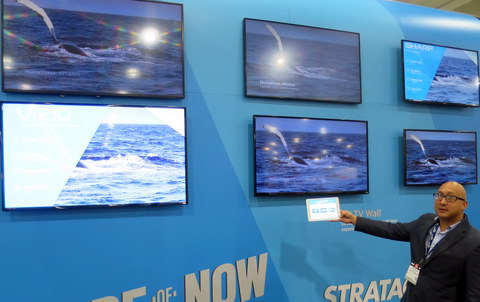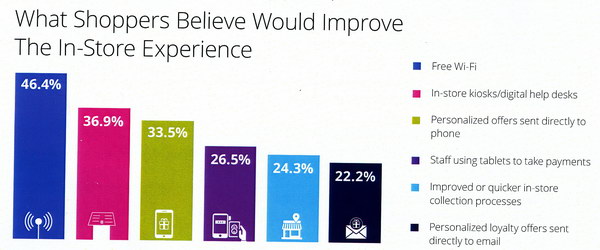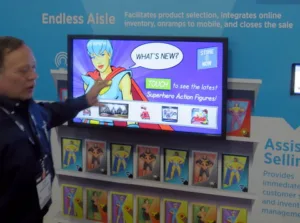One common phrase I saw from multiple exhibitors was “Endless Aisle.” This was an in-store kiosk system. If a customer didn’t find what she wanted in the store, she could find the closest item in the store and then search for similar items on the kiosk. Not surprisingly, all the endless aisle kiosks that I saw used relatively large touch screen displays. The software driving the kiosk would keep suggesting things to the customer: different sizes, different colors, different finishes, other items with a similar fit but slightly different design, other items that target the same demographic, items that would accessorize with the original item, etc. The displays could also highlight the latest products, as can be seen in the Stratacache display of superhero action figures, and direct customers to the store location where they were in stock. More generally, however, the idea was that the customer would be able to search endlessly and the computer driving the kiosk would never run out of suggestions. In the end, any item selected could be delivered to either the retail store or directly to the customer’s home, depending on how the retailer or the brand controlling the kiosk set up the software.
Endless Aisle touch screen kiosk at the Stratacache booth.
When brands controlled the kiosk, rather than the retailer, the endless aisle kiosk could be limited to showing only a single brand. For example, if the Stratacache display in the image was controlled by Marvel Entertainment LLC, only Marvel super hero action figures could be shown. Alternatively, Marvel figures could be given preference, but other super hero figures could be shown with lower priority.
This endless aisle approach benefits both the retail store and the customer. The customer can see, feel and try samples of things similar to what they want to buy but still have the full range of products available in all sizes and all colors. From the retail store point of view, it has the benefit of drawing customers into the store. When the customer buys something from the endless aisle kiosk, the brick-and-mortar store can get a share of the profits from what is essentially an on-line sale. After all, the store provided the venue and the samples of merchandise at significant cost and should get a share of the sale to reimburse it for those costs. This is far better, from the store’s point of view, than have the customer look at the item in the store and then go home and order it from Amazon or some other on-line retailer. When the customer does that, the store bears the costs but gets no share of the revenue.
Stratacache is a company that has a wide interest in retail technology, including digital signage, network design, implementation and operations, research & analytics, etc. (and has recently been buying companies in digital signage, including Scala – Stratacache Acquires Scala for Global Expansion & Stratacache Buys Real Digital Media). One thing they were showing was their smart video server for retail stores. This server could show the same video signal on multiple TVs. From a tablet or other touch screen in the shop, a TV buyer could select what type of TV they wanted, by brand, size, resolution, cost, etc. The server would then dim-out the other sets in the display. In the photo, 4K TVs are selected and all except the one 4K TV in the display are dimmed out. This technology is a new introduction. Older Stratacache video servers without this capability are common in the field. The representative said Wal-Mart used these normal Stratacache servers in their stores.
 Demonstration of the Stratacache smart video server with the company rep and the control tablet at the NRF show
Demonstration of the Stratacache smart video server with the company rep and the control tablet at the NRF show
One of the recent marketing buzzwords is “omnichannel.” This is a retail concept closely related to the endless aisle. The concept is to integrate in-store and on-line sales into a coherent whole. In-store, omnichannel sales can be accessed via a kiosk (endless aisle), a customer smartphone or tablet, a tablet used by a store employee or at the POS checkout. The omnichannel concept is based on the fact that many retail transactions begin using one media, say a smartphone app, and proceed to another media, say a retail store or an on-line store accessed using a web browser. The concept also includes how the customer receives the products, including buy in the store and receive in the store, buy on-line and pickup in the store, buy on-line and have it shipped or buy in the store and have it shipped.
Two companies that I could see were pushing the omnichannel concept. Avery Dennison Retail Branding and Information Solutions (RBIS) hosted a panel (which I did not attend) on the benefits of its RFID technology and how it could enable the omnichannel concept through inventory control. The basic idea is that if you don’t know what you have or where it is, you cannot supply it to customers through any channel, let alone omnichannel. iVend Retail by CitiXsys distributed their 2016 survey on consumer expectations. One overriding theme from all the consumer answers it the consumers want to use their mobile devices, even in-store. This desire varies strongly by age, as would be expected.
 Source: iVend Retail 2016 – 2017 Shopper Survey Report
Source: iVend Retail 2016 – 2017 Shopper Survey Report

